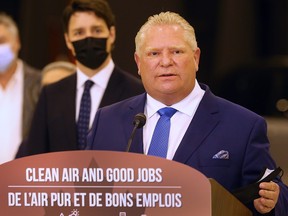
Article content material
With automotive corporations dedicated to completely making electrical automobiles by 2040 and with jurisdictions all over the world investing to safe their portion of the multitrillion-dollar local weather transition, Canada needed to transfer shortly to make sure the way forward for its automotive sector.
Commercial 2
Article content material
Canadian governments have considerably controversially invested billions of {dollars} in EV initiatives that benefit from Ontario’s distinctive sector ecosystem, however given the outsized function that car manufacturing performs in Ontario’s financial system, these investments ought to come as no shock.
Article content material
Within the final three years, Ontario has secured $26 billion in automotive and EV-related investments. Merely put, it’s too early to again away, particularly throughout the GTA, the place failure to safe investments could be the demise knell for Canada’s $16-billion auto sector.
The largest menace, after all, is our neighbour to the south. Earlier this yr, Ford Motor Firm introduced it could be investing $3.5 billion to construct an EV battery facility in Marshall, Mich., largely as a result of huge U.S. federal subsidies made accessible via the Inflation Discount Act.
Article content material
Commercial 3
Article content material
Really useful from Editorial
-

Closing electric-vehicle mandate to come back Tuesday, gross sales should double by 2026
-

Audi CEO nudges again EV fashions rollout amid market wobbles
In response to Ford, the IRA labored precisely as supposed, permitting Ford to deliver forth 2,500 jobs and the long run development that comes with them.
Ford, after all, isn’t the one automotive firm benefiting from subsidies to construct battery manufacturing vegetation. Tesla, which had been contemplating manufacturing in Germany, is predicted to separate $1.8 billion with its battery companion Panasonic, whereas Common Motors and LG Vitality Options are anticipated to obtain $480 million.
Even corporations with no North American manufacturing, comparable to Audi, have been contemplating vegetation within the U.S. Uptake on this system is so scorching that Goldman Sachs estimated the subsidies might find yourself totalling $1.2 trillion US, 3 times greater than U.S. authorities’s unique estimate.
Commercial 4
Article content material
In response, Ontario and the federal authorities collectively put $259 million into GM’s transformation of its Ingersoll and Oshawa vegetation. They mixed once more to take a position over $1 billion in Stellantis for meeting vegetation in Windsor and Brampton. Ontario even supplied $23.6 million in funding to Magna Worldwide for its introduced $471-million Brampton facility and web site growth funding. And, after all, there’s the $13.9-billion funding over 10 years from the federal authorities for the Volkswagen battery plant in St. Thomas.
This kind of assist is required if Ontario is to face an opportunity of competing with U.S. jurisdictions.
RECOMMENDED VIDEO
Compared again in Michigan, the U.S. Division of Vitality supplied a $2.5-billion mortgage to GM and LG Vitality Options on high of their IRA subsidies. GM additionally acquired $666 million in state grants in addition to a discount charge on electrical energy from the town’s utility.
Commercial 5
Article content material
That is how our neighbours are attracting multibillion-dollar inexperienced investments, creating alternatives and good jobs within the new financial system.
The danger is that these new investments is not going to be sufficient to reinvigorate our declining auto sector.
World automotive producers want to increase their financial footprint in North America. Failing to proceed competing for EV initiatives will harm Canada’s manufacturing sector and its world competitiveness in the long term. That is very true when our greatest rivals are pulling out the entire stops to safe these high-value jobs and the productiveness features that include them. Giant-scale enterprise investments might have appeared daring on the time, however pulling out of the race now looks like leaving enterprise unfinished.
— Gherson is president and CEO of the Toronto Area Board of Commerce.
Article content material


